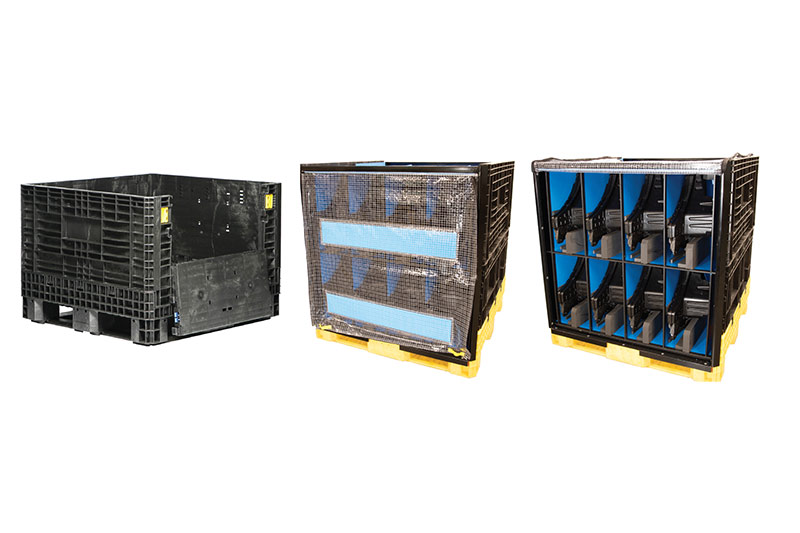Protecting those special-finish, highly visible parts
A customized bulk container design prevents scratches and more on its way from the dock to lineside assembly.

Let me count the ways that a special-finish, highly visible part can get scratched, abraded or otherwise marred, rendering it unusable:
- rough lift truck handling of bulk containers loaded with these parts,
- careless handling at the shipping dock,
- uneven highway travel,
- more rough handling at the receiving dock, and
- hapless handling when delivered lineside for final assembly.
That’s five obvious opportunities with, in all likelihood, others lurking in the shadows.
Whatchyagonnado?
Mark Ward,business development manager atSchaefer Plastics North America, has a suggestion. He calls it the Guardian. Seems like an appropriate name, actually.
What he’s talking about is a somewhat deconstructed standard plastic bulk container. One or two plastic walls are removed and a steel frame is put around the container to maintain its structural integrity. Meanwhile, various structures or cells are added into the container to individually hold and protect those sensitive parts. If you’re having trouble envisioning this (yes, I had trouble, too), check out the photos below.
The most interesting recent application for the Guardian, says Ward, is shipment of high-end speakers for a line of luxury cars. Each speaker is each loaded into its own cell (16 total in the container) and protected from touching each other and any other surfaces during storage and transport.
But there’s still another angle here. The speakers are loaded from either side into their cells in a particular orientation. When they arrive lineside, assembly workers simply reach into a cell, remove the part and install it in the car without any change in orientation. Can’t do much more than protect the part and make it so easily accessible for speedy assembly.
Sounds easy enough, but this custom bulk container didn’t just happen. Ward says it took several iterations and extensive vibration testing to ensure the parts would arrive unscathed. Fortunately, mission accomplished.
And he says this isn’t the first time the Guardian design has solved a tough bulk packaging problem. Ward says three key objectives are important when working through designs that range from rigid cells to hanging bags.
First is to protect the part from damage.
Second is getting as many parts as possible into the container. “The idea here,” says Ward, “is to fully load each container and get as many parts as possible onto each truckload. That saves fuel and minimizes trips to move thousands and thousands of parts. The end result is a reduced carbon footprint.”
The third objective is to do all this as economically as possible. But it’s worth noting that this is economy as defined by ensuring all parts are protected.
By the way, there’s a protection-of-the-environment benefit here beyond what was mentioned in point two.
Ward explains that SSI Schaefer has a program that takes back bulk containers, as well as totes and bins, from users once the useful life has been reached. SSI Schaefer credits users on future purchases the going rate for recycled plastic from those containers and then recycles the plastic for reuse. Not a bad program.

Article Topics
Packaging News & Resources
Optimizing S&OP for CPG & Retail: Visibility and Agility for Fast Changing Markets Gaining Crucial Business Insights Through Supply Chain IoT How to Keep Packaging from Becoming the Weak Link in Supply Chain Digitalization Harness the Strategic Power of Labeling Packaging is the major theme of ProMatDX Day 3 2021 Top 5 Trends in Labeling ProMat goes digital with ProMatDX 2021 More PackagingLatest in Logistics
Scheduling Standards Consortium publishes API Standard for TMS Worldwide Express, GlobalTranz, and Unishippers band together to establish the WWEX Group Uber Freight heralds various new customer-focused supply chain technology offerings U.S. rail carload and intermodal volumes are up, for week of September 23, reports AAR FTR Shipper Conditions Index takes a step back, from June to July Prologis and Home Depot leadership address the capabilities of AI for logistics ShipStation report examines holiday season shopping preferences More LogisticsAbout the Author
Subscribe to Logistics Management Magazine

Find out what the world's most innovative companies are doing to improve productivity in their plants and distribution centers.
Start your FREE subscription today.
September 2023
万博2.0app下载

Latest Resources






